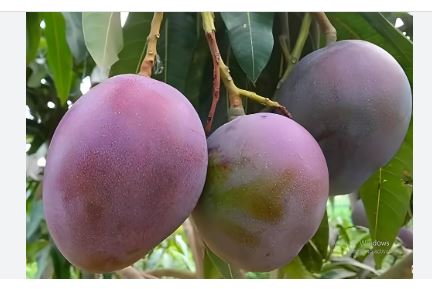
The Palmer mango is classified as Mangifera indica, a species within the Anacardiaceae family, commonly known as the cashew or sumac family, which also includes pistachios and poison ivy. The genus Mangifera comprises about 35-40 species of tropical fruiting trees, though M. indica is the dominant cultivated species, encompassing hundreds of cultivars worldwide. Palmer is a monoembryonic variety, meaning its seed produces a single shoot, distinguishing it from polyembryonic types common in Southeast Asia. Originating as a cultivated selection rather than a wild species, it reflects the diverse breeding efforts within this globally significant fruit tree.
The Palmer mango emerged in South Florida, with its original tree grown from a seed planted around 1925 on the property of Mrs. Victor Mell in Miami. For decades, its parentage was unclear, but a 2005 pedigree analysis suggested it’s a seedling of the Haden mango, a prominent early Florida cultivar derived from Indian stock. First propagated in 1945 and officially named in 1949, Palmer gained modest commercial traction in Florida by the mid-20th century. Though overshadowed by varieties like Tommy Atkins and Keitt in large-scale markets, it remains cultivated on a limited basis in Florida, as well as in regions like Africa, Australia, and India. It’s preserved in collections like the USDA’s germplasm repository in Miami and the University of Florida’s Tropical Research and Education Center in Homestead, reflecting its enduring horticultural value.
Palmer mangoes are notably large, with some specimens reaching several pounds, though they typically average 1-2 pounds. The fruit is oblong to oval, with a thick, smooth skin that transitions from green to a striking red-purplish hue when ripe, often with a yellow undertone or blush. The flesh is a deep orange-yellow, firm yet juicy, with minimal fiber, encasing a single, flat, monoembryonic seed. Ripening from July to early September in Florida, it’s a late-season cultivar, extending the mango harvest window. The taste is mild and aromatic, blending sweetness with a subtle tartness, often described as less intense than other varieties but pleasantly balanced, with a smooth, velvety texture that appeals to those who prefer a less fibrous mango.
Mangifera indica ‘Palmer’ thrives in USDA zones 10-11, where frost-free, tropical to subtropical conditions prevail, with temperatures ideally between 70-95°F (21-35°C). It can tolerate brief dips to 30°F (-1°C), but prolonged cold below this damages or kills the tree, limiting its range in the U.S. to southern Florida, parts of coastal California, Hawaii, and Puerto Rico. In zones 9b-10, it can be grown with protection (e.g., greenhouses or frost blankets) if started indoors and shielded from winter chill, though fruiting may be less reliable. It requires full sun (6-8 hours daily) and well-drained, sandy loam soil (pH 5.5-7.5), excelling in humid environments with annual rainfall of 30-100 inches or supplemental irrigation.
Culinary Applications of Palmer Mangoes
- Fresh Eating: Their juicy, mildly sweet flesh with minimal fiber is perfect for peeling and eating raw as a refreshing snack.
- Salads: Diced or sliced, they add a smooth, sweet-tart flavor to fruit or green salads, pairing well with lime or cilantro.
- Smoothies: Blended with yogurt or juice, they create creamy, aromatic drinks, enhancing tropical blends with their velvety texture.
- Salsas: Chopped with chili, onion, and herbs, they make a vibrant salsa, balancing spice with subtle sweetness for fish or chips.
- Desserts: Pureed for sorbets, mousses, or cakes, their rich flavor shines in sweets, often needing little added sugar.
- Chutneys: Cooked with spices and vinegar, they form a tangy, sweet condiment, complementing curries or grilled meats.
- Juicing: Pressed into juice, they yield a smooth, fragrant drink, great alone or mixed with citrus for a tropical twist.
Cultivation of Palmer Mangoes
- Climate: Palmer thrives in tropical to subtropical climates with warm temperatures (70-95°F/21-35°C) and high humidity. It requires frost-free conditions year-round for optimal growth and fruiting.
- USDA Zones: Best suited to USDA zones 10-11, where temperatures rarely drop below 30°F (-1°C). In zone 9b, it can be grown with frost protection (e.g., greenhouses or blankets), but cold snaps reduce yield.
- Soil: Requires well-drained, sandy loam soil with a pH of 5.5-7.5. It tolerates poor soils but excels with organic matter added; waterlogging harms its shallow, fibrous roots.
- Sunlight: Demands full sun (6-8 hours daily) for robust growth, flowering, and fruit development. Shade stunts trees and diminishes fruit quality and size.
- Planting: Propagated via grafting onto rootstocks like Turpentine or Number 11 for disease resistance and vigor, ensuring true-to-type fruit (seeds don’t breed true). Space trees 25-35 feet apart, planted in spring after frost risk passes.
- Watering: Needs consistent moisture—1-2 inches weekly—during establishment and dry seasons, especially pre-flowering (late winter) and fruit growth (spring-summer). Reduce water post-harvest to encourage dormancy; overwatering causes root rot.
- Support: Young trees may need staking for 1-2 years to protect against wind due to shallow roots. Mature trees (20-40 feet tall) are sturdy but benefit from pruning to maintain shape and accessibility.
- Pollination: Monoecious flowers (both male and hermaphrodite) bloom in late winter to spring, self-pollinating but benefiting from cross-pollination via bees or flies. Hand-pollination or nearby mango varieties (e.g., Haden) boost fruit set in low-pollinator areas.
- Pests: Susceptible to mango seed weevils, fruit flies, and scale insects. Use traps, neem oil, or wrap fruit in bags; natural predators like wasps help, and sanitation (removing fallen fruit) reduces infestations.
- Diseases: Prone to anthracnose, powdery mildew, and bacterial black spot. Apply copper fungicides pre-bloom, ensure airflow with pruning, and avoid overhead watering—Palmer has moderate resistance compared to some cultivars.
- Harvest: Fruits ripen late season (July-September in Florida), picked when red-purple with a slight give (not soft). Harvest with clippers, leaving a short stem; mature trees yield 50-200 lbs annually, depending on size and care.
- Yield: Begins fruiting 3-5 years after grafting, peaking at 7-15 years with 100-300 mangoes per tree under optimal conditions. Prune lightly post-harvest to remove dead wood and encourage next season’s flowering; lifespan reaches 50-100 years.